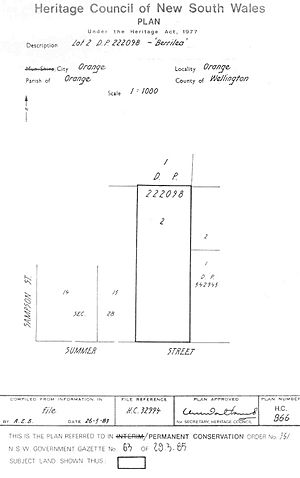Berrilea facts for kids
Quick facts for kids Berrilea |
|
|---|---|

Heritage boundaries
|
|
| Location | 29 Summer Street, Orange, City of Orange, New South Wales, Australia |
| Built | 1902 |
| Built for | Mrs Robert Frost |
| Architect | John Job (J. J.) Copeman |
| Architectural style(s) | Edwardian |
| Owner | Uniting Church in Australia |
| Official name: Berrilea; Berrilee; Tabratong | |
| Type | State heritage (built) |
| Designated | 2 April 1999 |
| Reference no. | 361 |
| Type | House |
| Category | Residential buildings (private) |
| Builders | J H Gain |
| Lua error in Module:Location_map at line 420: attempt to index field 'wikibase' (a nil value). | |
Berrilea is a beautiful old house located at 29 Summer Street in Orange, Australia. It's also known as Berrilee or Tabratong. This special home was designed by an architect named John Job (J. J.) Copeman and built by J. H. Gain. It was finished in 1902. Today, the Uniting Church in Australia owns the property. Berrilea is very important because it's listed on the New South Wales State Heritage Register. This means it's a protected historical site.
The Story of Berrilea
Berrilea was built in 1902 for a woman named Mrs. Robert Frost. The architect, J. J. Copeman, designed it, and J. H. Gain was the builder.
This house is in a great spot on the main street of Orange. It's right across from Cook Park. Because of its location and lovely design, it's a key part of the town's look.
The first owner was Robert Frost, who was a big brick-maker in the area. Later, a person named P. C. Weston bought the house. His daughter, Miss F. Weston, later gave it to the church. She wanted it to be used with the nearby Wontama Private Hospital. The bathroom in the house was changed a bit in the 1930s.
In 1983, Berrilea was officially given to the Uniting Church. The church's Wontama Village Nursing Home has been using parts of the land since 1967. At first, they thought about turning the house into small apartments. But in May 1987, it became the Wontama Day Care Centre. It also held the administration office for the church. Later, in 1991, 24 self-contained units called "Carinya" (which means 'Happy home') were opened nearby.
In 2011, the Orange City Council officially listed Berrilea on its Local Environmental Plan. This recognized its importance as a state heritage item.
What Berrilea Looks Like
Berrilea is a wonderful example of Edwardian style. This type of architecture was popular in the early 1900s. The house has wide wooden verandahs, which are like covered porches, and pretty decorative metalwork. It also has a large, formal garden. At the back, there used to be stables, but now they are a double garage.
The house is made of brick with a special pattern called Flemish bond. The bricks also have "tuckpointing," which makes the mortar lines look neat. The roof is sloped, called a hipped roof, and is made of slate. It has fancy chimneys and a part that sticks out called a roughcast gable.
The verandah wraps around three sides of the house. It has cast iron columns that look like ancient Greek columns. There are also beautiful decorative cast iron brackets and valances. The verandah roof is made of iron and is straight. Above the main door, there's a gabled portico, which is a covered entrance.
The windows have decorative brackets. There's also a special line of plaster, called a string course, at the bottom of the windows. The front door has colorful leadlighting, which is glass with lead lines forming patterns. Three French doors open from inside the house onto the verandah.
Most of the inside of the house is still original. Only a few things have changed, like the bathroom in the 1930s and the fireplaces in the drawing room and dining room.
The old stables at the back are made of plain brick, just like the house. They have a wooden part added to the back. There's also a tall tankstand attached to the stables. This stand holds a water tank high up and is still used today, especially when there isn't much rain.
Why Berrilea is Special
Berrilea was officially added to the New South Wales State Heritage Register on April 2, 1999. This means it's recognized as an important historical place that needs to be protected for future generations.

